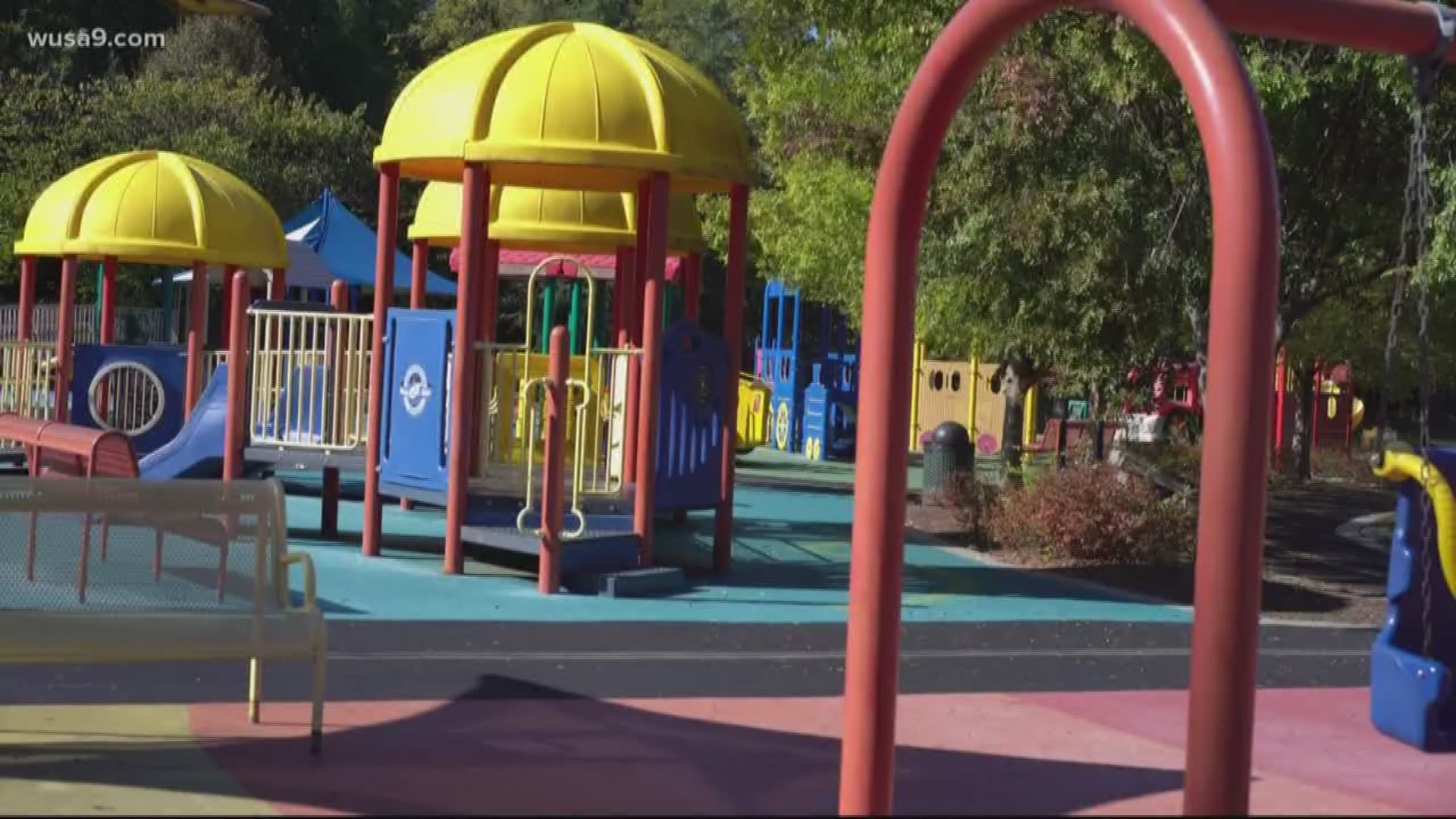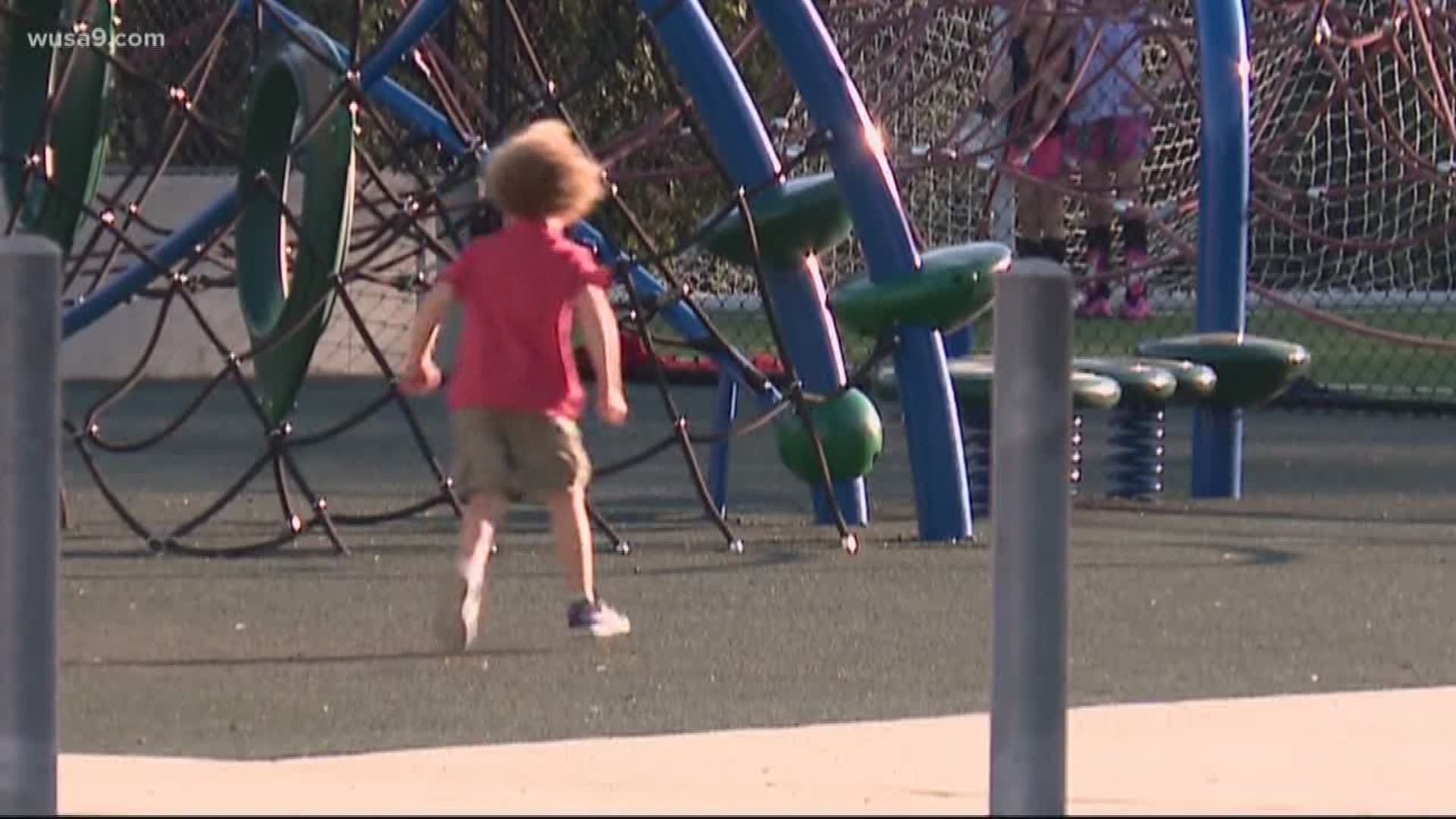Update: 03/10/2020:
D.C. Department of General Services Director Keith Anderson told WUSA9 Tuesday the District will now stop painting its rubber playground mats without first approving the chemicals used. Tests commissioned by D.C.'s government found colorful playground rubber mats, particularly those colored orange, had the highest risk for lead contamination. Many of those orange crumb rubber mats now look pink after years of sun-staining.
"What we found was there was no lead in the actual components of the PiP-- (Poured in Place crumb rubber) the lead was contained in the dye, or the pigment, or the paint that colored the poured in place," Anderson said. "Whereas we may have solved for any runoff it [lead] could come from somewhere else. We want to make sure that we continue to maintain these playgrounds, we continue to HEPA vacuum them and power wash them."
Speaking about initial test results since May indicating elevated lead levels at multiple D.C. school playgrounds, Anderson replied, "We really appreciate the work that the Ecology Center performed. And we understood their results."
The Ecology Center offered to share their samples in 2019 of tested crumb rubber. That offer was not accepted. When asked Tuesday if D.C. would consider sharing their samples of tested crumb rubber with other labs for peer-reviewed companion studies, Anderson replied, "not at this time."
D.C. DGS pledges to continue power washing and vacuuming playground at schools and parks for possible lead exposure "at least twice a year."
Original Story: 03/06/2020
The D.C. government recently removed some rubber mats from playgrounds at District schools and parks after finding high levels of potentially toxic lead. Tests commissioned by the parental group D.C. Safe & Healthy Playing Fields released in May first revealed high lead levels at Janney Elementary School.
Further parental complaints to the DC Council compelled the city's Department of General Services to commission studies of its own. Those results, anticipated for months by DC Councilmember Robert White, were released late Friday night.
18 playgrounds identified as having lead levels above the acceptable levels of 400 parts per million have been vacuumed, pressure washed, and re-evaluated according to the report. The vacuuming efforts were able to collect and dispose of chunks of rubber that may be picked up and ingested. This reduced the lead hazards from ingestion of the loose PIP rubber chunks, according to the report.
Playgrounds that came back as positive for "actionable" lead levels:
- Aiton Elementary School
- Bancroft Elementary School
- Cardozo Education Campus
- Dorothy I. Height Elementary School
- Eaton Elementary School
- H.D. Cooke Elementary School
- Janney Elementary School
- Langdon Educational Campus
- Luke C. Moore
- Nalle Elementary School
- Oyster-Adams Bilingual School (Adams Campus)
- River Terrace Education Campus
- Roosevelt High School
- Shepherd Elementary School
- Thomas Elementary School
- Thomson Elementary School
- Truesdell Education Campus
- Turner Elementary School
The report also estimates how lead is entering the playground's rubber mats:
"Lead migration from nearby building’s historical or current lead paint flaking and/or leaching (61%). Lead migration from local area’s lead-contaminated soils (Estimated < 8%). Lead migration from nearby historical or current construction activities involving lead-based material contamination such lead-based paint, flashing, ceramics, etc. (26%) Miscellaneous lead contamination e.g. local discharge of weapons, gun shell casings (found on some playgrounds), transport of other lead-containing materials such as scooters and toys, tracking local sources of lead onto playgrounds, etc. (Estimated < 5%)."


This report written by testing firm SALuT is more than 2,000 pages long. Here is a summary of some key findings:
Aiton Elementary School
Of the school's three playgrounds, two did not have levels of lead above actionable levels, according to the report. However, playground A nearest the school building had elevated levels of lead, due to contamination of the playground from lead-containing paint that had chipped or leached from the school building. Even after surface vacuuming, levels of lead in the crumb rubber remained high. Shortly after the final evaluation, the rubber playground A was removed altogether. Aiton school’s remaining playgrounds do not indicate hazardous levels of lead, according to the report.
Eaton Elementary
These playgrounds are targeted in the report as "very age-worn with multiple patches, cracking and degradation. It was understood that these playgrounds will be demolished." The report recommends that if the playground "is not demolished, it is recommended that a lead risk assessment of nearby building exteriors be conducted and remove or otherwise stabilize any identified lead-based paint. Additionally, it is recommended that a thorough pressure washing be conducted using the methods and protocol described in the final report."
Luke C. Moore High School
The report had this to say about the daycare playground: "It was placed up against the building and fenced around the remaining perimeter. There wooden windows above the playground that has lead-based paint chipping off onto the playground. Additionally, there are extensive white stains below the windows that have been identified as having very high levels of lead that is leaching from the window sills. These stains wipe off easily and can readily get onto hands, clothes, or other skin parts of children. The black fence partially surrounding the playground has lead-based paint coating that shows a large amount of flaking and peeling. These lead chips find themselves on the playground as well. The lead paint chips and the leachate are getting into the rubber playground as evidenced by the highly elevated levels of lead in the bulk rinsate. While the wipe testing of the mat did not indicate accessible lead on a playground in good condition, it would be highly probable that these high levels of lead would readily become available if the rubber playgrounds surface becomes damaged. It is recommended that the playground be removed, the area thoroughly cleaned and replaced with a lead-free rubber playground."
Truesdell Education Campus
"Sources of lead that most likely are causing the playground contamination include the school buildings wood window sills, facia, wood doorways, etc., that contain lead in the paint. Lead was also detected in the paint of the cast-iron roof drain pipes, on the white staining on bricks of the walls beneath the lead-containing painted wood. This is highly likely due to leaching of the leaded paint down the sides of the building and onto the asphalt pavement. Additionally, the two metal benches between playground A (northern) and the school building contain lead painted metal. However, recent testing of these types of lead paint and other lead-containing playground equipment indicates that those sources of lead are stable and are not collectible by wipe sampling. This is a high indication that the lead in the equipment will not come off in children’s hands, shoes, clothes, etc. and do not pose a significant health hazard under most conditions and uses."


No Department of Parks and Recreation playgrounds tested positive for lead according to D.C.'s report. It adds that all were tested.
This is a developing story and more will be added in the coming days.


